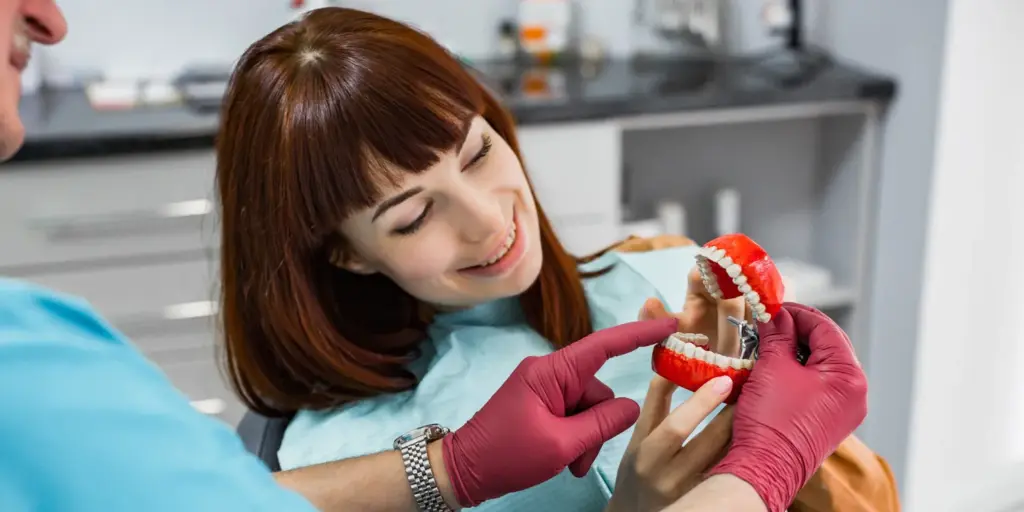Dental Inlays and Onlays: Types, Benefits, and Procedures

Dental Inlays and Onlays: Types, Benefits, and Procedures
Have you ever had a tooth that was too damaged for a simple filling but didn’t need a full crown? If so, you might have heard the dentist talk about something called a dental inlay or onlay. These are like special, custom-made puzzle pieces that fit beautifully into your tooth to fix it up.
In this guide, we’ll break down everything you need to know about dental inlays and onlays. We’ll cover what they are, why they’re so great, and what it’s like to get them.
What Are Dental Inlays and Onlays?
Imagine your tooth has a cavity or has been cracked. A regular filling works well for small problems. But what if the damage is a bit bigger, but not so big that your whole tooth needs to be covered with a crown? That’s where inlays and onlays come in.
- Dental Inlays: Think of an inlay as a special filling that sits inside the chewing surface of your tooth. It’s made in a lab to fit the exact shape of the hole. It’s used when the damage is confined to the bumps on the top of your tooth, known as cusps.
- Dental Onlays: Now, imagine the damage is a bit bigger and goes over one or more of those bumps (cusps) on your tooth. An onlay is similar to an inlay, but it’s larger. It covers the inside of the tooth and also goes over the top of the damaged cusp to give it extra support. You can think of an onlay as being halfway between a filling and a full crown.
The main difference between an inlay and an onlay is simply how much of the tooth they cover. An inlay fills in the centre, while an onlay also covers the edges, or cusps, of the tooth.
When Are Inlays and Onlays Recommended?
Dentists recommend dental inlays and onlays in specific situations. They are a fantastic choice when:
- A tooth has a large cavity that a standard filling can’t fix properly.
- A tooth has a crack or fracture that’s not big enough for a crown.
- An old, large filling is failing, and a new one isn’t a good option.
- The tooth is still mostly healthy, but a part of it needs to be restored to prevent it from getting worse.
The dentist, like Beaconsfield Dentist, will carefully examine your tooth, possibly take an X-ray, and then discuss the best solution with you. They might say, “This tooth has a big old filling that’s on its last legs. A dental onlay would be the best way to save it and make it strong again.”
Benefits of Dental Inlays and Onlays
There are many great reasons why both dentists and patients love inlays and onlays.
- They Save Your Tooth: One of the biggest benefits is that they help you keep more of your natural tooth structure. Unlike a crown, which requires significant tooth filing, inlays and onlays only remove the damaged part. This is a huge win for your long-term dental health.
- They’re Super Strong and Durable: Because dental inlays and onlays are made in a dental lab from materials like porcelain, composite resin, or even gold, they are much stronger and last much longer than a regular filling. They can withstand the chewing forces in your mouth for many years.
- They Look Fantastic: Porcelain inlays and onlays are made to match the exact colour of your tooth. Once they’re in place, it’s very hard to tell the difference between your natural tooth and the restoration. This is great for your front teeth and your back teeth, giving you a beautiful, seamless smile.
- They’re Made to Fit Comfortably: Since they’re custom-made in a lab, they fit your tooth like a glove. This means there are no tiny gaps where bacteria can hide and cause new decay. This best fit helps to protect your tooth for the future.
- They Prevent Further Damage: An onlay, in particular, strengthens the tooth by holding the cusps together. This is a bit like a helmet for your tooth. It stops the tooth from cracking or breaking apart when you chew.
The Process of Getting Inlays and Onlays
Getting a dental inlay or onlay usually takes two visits to the dentist, which is a simple process.
First Visit
- Numbing: The dentist will first make sure you’re comfortable by numbing the area around your tooth.
- Removing the Damaged Part: They will then carefully remove any old filling or decay, preparing the tooth for the new inlay or onlay.
- Taking an Impression: Once the tooth is clean and shaped, the dentist will take a detailed impression (a mould) of it. This mould is sent to a dental lab where the skilled technicians will create your custom-made inlay or onlay.
- Temporary Filling: To protect the tooth while you wait, the dentist will place a temporary filling over it.
Second Visit
- Checking the Fit: A week or two later, you’ll come back. The dentist will remove the temporary filling and carefully check that your new inlay or onlay fits comfortably.
- Bonding: Once everyone is happy with the fit, the dentist will use a strong dental cement to bond the inlay or onlay onto your tooth. They will use a special light to make sure it’s fully hardened and secure.
- Final Touches: They’ll then polish the surface and check your bite to make sure everything feels just right. And that’s it! Your tooth is now strong and healthy again.
How Long Do Inlays and Onlays Last?
One of the great things about dental inlays and onlays is their longevity. With proper care, they can last for a very long time.
- Typically, they last between 10 and 30 years. The exact lifespan depends on several factors, including the material used (porcelain or gold generally lasts longer), your oral hygiene, and your lifestyle (for example, if you grind your teeth, they might not last as long).
- Porcelain Inlays and Onlays are a popular choice because they look great and are very durable. They are resistant to staining and wear, making them a long-lasting and beautiful solution.
Inlays vs. Fillings vs. Crowns: What’s the Difference?
It can be confusing to know which option is best. Here’s a simple breakdown:
- Filling: A filling is a material (like composite resin) that is placed directly into a small cavity during a single visit. It’s the go-to for small to medium-sized holes.
- Inlay/Onlay: This is a custom-made restoration that is made in a lab and then bonded to the tooth. It’s used for larger areas of decay or damage that are too big for a filling but don’t need a full crown. It’s a great “middle ground” option.
- Crown: A crown is a complete cap that covers the entire chewing surface and sides of the tooth. It’s used when a tooth is severely damaged, cracked, or has had a root canal. It’s the most extensive restoration.
In a nutshell:
- Small Damage: Filling
- Medium Damage: Inlay or Onlay (also known as a partial crown)
- Major Damage: Crown (a full crown)
Aftercare for Dental Inlays and Onlays
Looking after your new inlay or onlay is pretty easy. The good news is that you just treat it like a regular tooth!
- Brush and Floss: Continue to brush your teeth at least twice a day and floss daily. This is the most important thing you can do to keep your restoration and the rest of your teeth healthy.
- Avoid Chewing on Hard Things: Try not to chew on super hard foods like ice or nuts, as this could damage any restoration, including your natural teeth.
- Regular Check-ups: Make sure you visit the dentist for your regular check-ups and cleanings. The dentist Forest Hill will check on your inlay or onlay to make sure it’s still in great shape.
Cost of Inlays and Onlays
The cost of dental inlays and onlays can vary. It depends on:
- The material used (porcelain and gold are generally more expensive than composite resin).
- The size of the restoration.
- The location of the tooth.
- The fees of the dental practice.
While they may be more expensive upfront than a simple filling, remember that their long lifespan often makes them more cost-effective in the long run. They can last for decades, saving you from having to get the same tooth repaired over and over again.
Conclusion
Dental inlays and onlays are an excellent solution for restoring teeth that have been damaged or have large old fillings. They are a strong, long-lasting, and natural-looking way to save your tooth without the need for a full crown. By choosing an inlay or onlay, you are making a great investment in your dental health and preserving more of your natural tooth structure.
Don’t Settle for Anything Less
If you have a tooth that might benefit from this kind of restoration, the best thing to do is chat with our dentist at Brentford Dental. We can give you a thorough check-up and let you know if a dental inlay or onlay is the right choice for you.
To find out more and get a professional opinion, book a consultation with us, Berwick Dental, today. We are the experts who can help you keep your smile healthy and strong for years to come.




